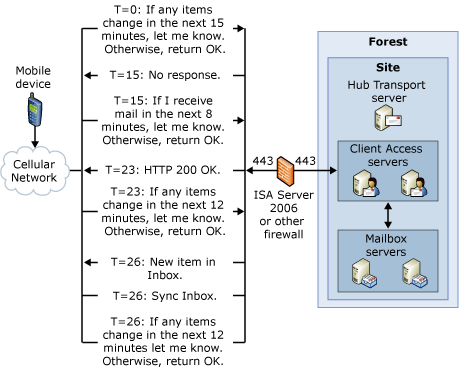Applies to: Exchange Server 2007 SP3, Exchange Server
2007 SP2, Exchange Server 2007 SP1, Exchange Server 2007
Topic Last Modified: 2007-01-23
Exchange ActiveSync in Microsoft Exchange Server 2007 is designed to give information workers access to a significant amount of their mailbox data on a mobile device. After you have deployed Exchange 2007, your users automatically have access to Exchange ActiveSync. This topic contains information about Exchange ActiveSync that you can give to your information workers.
 Understanding Exchange
ActiveSync Functionality
Understanding Exchange
ActiveSync Functionality
Exchange ActiveSync uses Direct Push to synchronize e-mail messages, calendar, contact, and task data with the mobile device. Exchange ActiveSync and Direct Push work by establishing two-way communication between the mobile device and the Exchange server, as shown in Figure 1. The device initiates a longstanding HTTPS request to the server. The server monitors the mailbox for the duration of the request. If new items arrive in the mailbox or synchronized folders within the duration of the request, the server notifies the device and requests that the device initiate synchronization. If there are no changes to the monitored folders within the duration of the HTTPS request, the request expires and a new request is generated by the device. This process keeps the device synchronized with the Microsoft Exchange mailbox.
Figure 1 Exchange ActiveSync Direct Push synchronization

When you use Exchange ActiveSync with Exchange 2007, you can use Direct Push functionality if you are using a device that is running Windows Mobile 5.0 with the Messaging & Security Feature Pack (MSFP) or a later version of Windows Mobile software. In addition, several third-party devices also support Direct Push. For more information about Direct Push, see the following topics:
 Understanding Exchange
ActiveSync Features
Understanding Exchange
ActiveSync Features
When you synchronize your mobile device with Exchange 2007, you will be able to do the following:
- Synchronize e-mail messages, calendar items, contacts, and
tasks between your Exchange 2007 mailbox and your mobile
device.
 Note:
Note:You cannot use Exchange ActiveSync to synchronize Microsoft Office Outlook notes from the Exchange server to a mobile device. E-mail messages, contacts, tasks, and calendar items are all synchronized. - Manage and configure Microsoft Exchange settings such
as Out of Office functionality. You can change your Out of
Office status and configure an Out of Office auto-reply.
- Read e-mail messages sent with restricted permissions by using
rights management.
- Search for names in the global address list (GAL).
- View e-mail messages with full HTML formatting, including
images.
- Perform a remote device wipe on a lost or stolen device from
Outlook Web Access.
- Recover a forgotten device password.
 Note:
Note:An Exchange ActiveSync mailbox policy must be running on the device to be able to recover a device password. If you are not sure if you have an Exchange ActiveSync mailbox policy, contact the system administrator for your organization. - Download and listen to voice mail messages by using
Exchange 2007 Unified Messaging.
 Caution:
Caution:When you use Pocket Internet Explorer to access Outlook Web Access Light, you may be able to listen to a voice message that is attached to an e-mail message. However, this is not a supported configuration, because Pocket Internet Explorer is not a supported platform for Outlook Web Access Light.  Note:
Note:Many of the features listed earlier require the latest version of Windows Mobile software, which is currently in development.
For more information about these features, see the following topics:
- Overview of
Exchange ActiveSync
- How to
Recover a Device Password
- How to
Perform a Remote Wipe on a Device
Troubleshooting Exchange ActiveSync
When problems occur while you are using Exchange ActiveSync, Exchange 2007 makes it easy for you to use Outlook Web Access to retrieve logs from a mobile device. These logs can be e-mailed to Exchange administrators so that they can help solve synchronization issues.
 Transitioning to Exchange
ActiveSync 2007
Transitioning to Exchange
ActiveSync 2007
Exchange Server 2007 offers significant improvements in Exchange ActiveSync for information workers. However, there are several features that are no longer available in Exchange 2007. Those features include Outlook Mobile Access and the ability to read S/MIME encrypted e-mail messages.
Outlook Mobile Access
With Microsoft Exchange 2000 Server and Exchange Server 2003, you could use a WAP-enabled cellular telephone to access your messages through Outlook Mobile Access. Outlook Mobile Access provided a view of messages that resembled Outlook Web Access over a WAP connection. This feature enabled you to access your messaging data without a mobile device that was enabled for Exchange ActiveSync. Outlook Mobile Access has been removed in Exchange 2007. You should use Exchange ActiveSync with your Windows Mobile or third-party device to synchronize your messaging data.
Accessing S/MIME Encrypted E-Mail Messages
With Exchange 2003, you could read S/MIME encrypted e-mail messages on your mobile device. Exchange 2007 does not support reading S/MIME encrypted e-mail messages on a mobile device. To read an e-mail message that is encrypted by using S/MIME, you must read the message by using Outlook.

